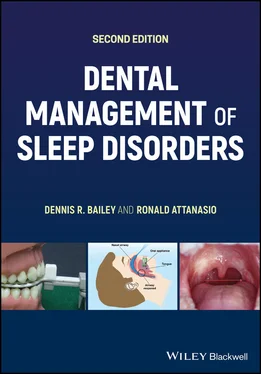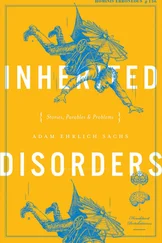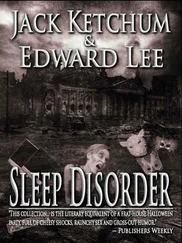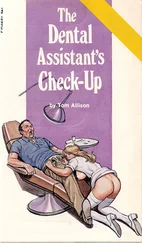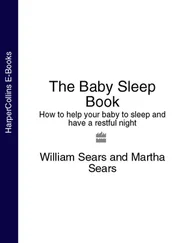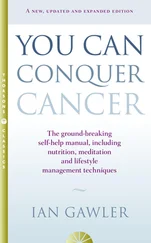Ronald Attanasio - Dental Management of Sleep Disorders
Здесь есть возможность читать онлайн «Ronald Attanasio - Dental Management of Sleep Disorders» — ознакомительный отрывок электронной книги совершенно бесплатно, а после прочтения отрывка купить полную версию. В некоторых случаях можно слушать аудио, скачать через торрент в формате fb2 и присутствует краткое содержание. Жанр: unrecognised, на английском языке. Описание произведения, (предисловие) а так же отзывы посетителей доступны на портале библиотеки ЛибКат.
- Название:Dental Management of Sleep Disorders
- Автор:
- Жанр:
- Год:неизвестен
- ISBN:нет данных
- Рейтинг книги:3 / 5. Голосов: 1
-
Избранное:Добавить в избранное
- Отзывы:
-
Ваша оценка:
- 60
- 1
- 2
- 3
- 4
- 5
Dental Management of Sleep Disorders: краткое содержание, описание и аннотация
Предлагаем к чтению аннотацию, описание, краткое содержание или предисловие (зависит от того, что написал сам автор книги «Dental Management of Sleep Disorders»). Если вы не нашли необходимую информацию о книге — напишите в комментариях, мы постараемся отыскать её.
Dental Management of Sleep Disorders
Dental Management of Sleep Disorders, Second Edition
Dental Management of Sleep Disorders — читать онлайн ознакомительный отрывок
Ниже представлен текст книги, разбитый по страницам. Система сохранения места последней прочитанной страницы, позволяет с удобством читать онлайн бесплатно книгу «Dental Management of Sleep Disorders», без необходимости каждый раз заново искать на чём Вы остановились. Поставьте закладку, и сможете в любой момент перейти на страницу, на которой закончили чтение.
Интервал:
Закладка:
Conclusion
Human sleep is a complex interrelationship between a wide variety of neurotransmitters and how they impact the brain and one another. Having a basic understanding of neuroanatomy as well as neurobiology is also important as it helps to understand brain function in sleep and wakefulness. Our sleep is no longer viewed as an alternate state of consciousness but rather a separate state of being with unique properties that are designed to facilitate improved health, mood, memory, and well‐being. Over time a better understanding of the neurotransmitters involved in sleep will no doubt occur, resulting in a better understanding of sleep. Ultimately, sleep is controlled by the brain and is for the brain.
References
1 1 Dement, W. and Kleitman, N. (1957). Cyclic variations in EEG during sleep and their relation to eye movements, body motility, and dreaming. Electroencephalogr. Clin. Neurophysiol. 9 (4): 673–690.
2 2 Loomis, A.L., Harvey, E.N., and Hobart, G.A. (1937). Cerebral states during sleep as studied by human brain potentials. J. Exp. Psychol. 21 (2): 127–144.
3 3 Rechtschaffen, A. and Kales, A. (1968). A Manual of Standardized Terminology, Techniques, and Scoring System for Sleep Stages of Human Subjects. National Institute of Neurological Disease and Blindness: Bethesda (MD).
4 4 Iber, C., Ancoli‐Israel, S., Chesson, A.L. et al. (2007). The AASM Manual for the Scoring of Sleep and Associated Events. Westchester, IL: American Academy of Sleep Medicine.
5 5 Swick, T.J. (2012). The neurobiology of sleep. Sleep Med. Clin. 7 (3): 399–415.
6 6 Bader, G., Gillberg, C., Johnson, M. et al. (2003). Activity and sleep in children with ADHD. Sleep 26: A136.
7 7 Gais, S., Molle, M., Helms, K. et al. (2002). Learning‐dependent increases in sleep spindle density. J. Neurosci. 22 (15): 6830–6834.
8 8 Kumar R, Birrer BVX, Macey PM, Woo MA, Gupta RK, Yan‐Go FL, Harper RM. Reduced mammillary body volume in patients with obstructive sleep apnea. Neurosci. Lett. 2008; 438:330–334. doi: https://doi.org/10.1016/j.neulet.2008.04.071
9 9 Lee‐Chiong, T. (2006). Sleep: A Comprehensive Handbook, vol. 3. Wilmington, DE: Wiley‐Liss/Wiley.
10 10 Martin, J.M., Andriano, D.W., Mota, N.B. et al. (2020). Structural differences between REM and non‐REM dream reports assessed by graph analysis. PLoS ONE 15 (7): e0228903. https://doi.org/10.1371/journal.pone.0228903.
11 11 Markov, D., Goldman, M., and Doghramji, K. (2012). Normal sleep and circadian rhythms – neurobiological mechanisms underlying sleep and wakefullness. Sleep Med. Clin. 7 (3): 417–426.
12 12 Jain, V. (2014). Poor sleep with age. Evaluation of sleep complaints. Sleep Med. Clin. 9 (4): 571–572.
13 13 Duffy, J.F., Dijk, D.J., Klerman, E.B. et al. (1998). Later endogenous circadian temperature nadir relative to an earlier wake time in older people. Am. J. Phsyiol. 275 (5 Pt 2): R1478–R1487.
14 14 American Academy of Sleep Medicine (2014). The International Classification of Sleep Disorders (ICSD3), 3e. Darien, IL: American Academy of Sleep Medicine.
15 15 Bliwise, D.L. (1993). Sleep in normal aging and dementia. Sleep 16: 40–81.
16 16 Ancoli‐Israel, S. (2005). Normal human sleep at different ages: sleep in older adults. In: SRS Basics of Sleep Guide (ed. Sleep Research Society), 21–26. Westchester, IL: Sleep Research Society.
17 17 Bliwise, D.L. (2005). Normal aging. In: Principles and Practice of Sleep Medicine, 4e (ed. M.H. Kryger, T. Roth and W.C. Dement), 24–38. Philadelphia: Elsevier/Saunders.
18 18 Hirshkowitz, M., Whiton, K., Albert, S.M. et al. (2015). National Sleep Foundation's sleep time duration recommendations: methodology and results summary. Sleep Health 1 (1): 40–43. https://doi.org/10.1016/j.sleh.2014.12.010.
19 19 Rouse, W. and Smith, M. (1992). Lucretius: On the Nature of Things, 34. Cambridge, MA: Harvard University Press.
20 20 von Economo, C. (1930). Sleep as a problem of localization. J. Nerv. Ment. Dis. 71: 249–259.
21 21 Berger, H. (1930). Ueber das elektroenkephalogram des menschen. J. Psychol. Neurol. 40: 160–179.
22 22 Lee‐Chiong, T. (2012). Foreword: biology of sleep. Sleep Med. Clin. 3: xi–xii.
23 23 España, R.A. and Scammell, T.E. (2011). Sleep neurobiology from a clinical perspective. Sleep 34 (7): 845–858.
24 24 Eban‐Rothschild, A., Appelbaum, L., and de Lecea, L. (2018). Neuronal mechanisms for sleep/wake regulation and modulatory drive. Neuropsychopharmacology 43: 937–952.
25 25 Stahl, S.M. (2002). Brainstorms clinical neuroscience update. J. Clin. Psychiatry 63 (6): 467–468.
26 26 Saper, C.B., Chou, T.C., and Scammell, T.E. (2001). The sleep switch: hypothalamic control of sleep and wakedfullness. Trends Neurosci. 24 (12): 726–731.
27 27 Theibert, A.B. (2020). Chapter 9: neurotransmitter systems II: monoamines, purines, neuropeptides, & unconventional neurotransmitters. In: Essentials of Modern Neuroscience, 159–176. McGraw Hill.
28 28 Wisor, J.M., Nishino, S., Sora, I. et al. (2001). Dopaminergic role in stimulant‐induced wakefulness. J. Neurosci. 21 (5): 1787–1794.
29 29 Fried, I., Wilson, C.L., Morrow, J.W. et al. (2001). Increased dopamine release in the human amygdala during performance of cognitive tasks. Nat. Neurosci. 4 (2): 201–206.
30 30 Steriade, M. and Hobson, J. (1976). Neuronal activity during the sleep‐waking cycle. Prog. Neurobiol. 6: 155–376.
31 31 Ursin R. Serotonin and sleep. Sleep Med. Rev. 2002; 6(1):57–69. doi: https://doi.org/10.1053/smrv.2001.0174
32 32 McCormick, D.A. (1992). Neurotransmitter actions in the thalamus and cerebral cortex. J. Clin. Neurophysiol. 9: 212–223.
33 33 Haas, H.L., Sergeeva, O.A., and Selbach, O. (2008). Histamine in the nervous system. Physiol. Rev. 88: 1183–1241.
34 34 Kanbayashi, T., Kodama, T., Kondo, H. et al. (2009). CSF histamine contents in narcolepsy, idiopathic hypersomnia and obstructive sleep apnea syndrome. Sleep 32 (2): 181–187.
35 35 Scammell, TE, Jackson AC, Franks NP, Wisden W, Dauvilliers Y. Histamine: neural circuits and new medications. Sleep 2019; 42(1):1–8. doi: https://doi.org/10.1093/sleep/zsy183
36 36 de Lecea, L., Kilduff, T.S., Peyron, C. et al. (1998). The hypocretins: hypothalamus specific peptides with neuroexcitatory activity. Proc. Natl. Acad. Sci. USA 95: 322–327.
37 37 Kryger, M.H., Roth, T., and Dement, W.C. (2017). Normal human sleep. An overview. In: Principles and Practice of Sleep Medicine. Elsevier Saunders.
38 38 Watson, C.J. and Baghdoyan, H.A. (2012). Neuropharmacology of sleep and wakefullness: 2012 update. Sleep Med. Clin. 7: 469–486.
39 39 Ghiciuc, C.M., Dima Cozma, L.C., Bercea, R.M. et al. (2013). Restoring the salivary cortisol awakening response through nasdal continuous positive airway pressure therapy in obstructive sleep apnea. Chronobiol. Int. 30 (8): 1024–1031. https://doi.org/10.3109/07420528.2013.795155.
40 40 Porkka‐Heiskanen, T., Strecker, R.E., Thakkar, M. et al. (1997). Adenosine: a mediator of the sleep‐inducing effects of prolonged wakefulness. Science 276 (5316): 1265–1268.
41 41 Gandhi, A.V., Mosser, E.A., Oikonomou, G., and Prober, D.A. (2015). Melatonin is required for the circadian regulation of sleep. Neuron 85: 1193–1199. https://doi.org/10.1016/j.neuron.2015.02.016.
42 42 Lüthi, A. (2016). Sleep: switching off the off‐switch. Curr. Biol. 26: R756–R777.
43 43 Farré, N., Farré, R., and Gozal, D. (2018). Sleep apnea morbidity a consequence of microbial‐immune cross‐talk? Chest 154 (4): 754–759.
44 44 Smith, R.P., Easson, C., Lyle, S.M. et al. (2019). Gut microbiome diversity is associated with sleep physiology in humans. PLoS ONE 14 (10): e0222394. https://doi.org/10.1371/journal.pone.0222394.
Читать дальшеИнтервал:
Закладка:
Похожие книги на «Dental Management of Sleep Disorders»
Представляем Вашему вниманию похожие книги на «Dental Management of Sleep Disorders» списком для выбора. Мы отобрали схожую по названию и смыслу литературу в надежде предоставить читателям больше вариантов отыскать новые, интересные, ещё непрочитанные произведения.
Обсуждение, отзывы о книге «Dental Management of Sleep Disorders» и просто собственные мнения читателей. Оставьте ваши комментарии, напишите, что Вы думаете о произведении, его смысле или главных героях. Укажите что конкретно понравилось, а что нет, и почему Вы так считаете.
